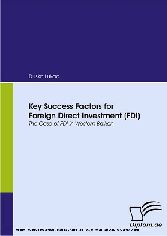Suchen und Finden
Mehr zum Inhalt

Key Success Factors for Foreign Direct Investment (FDI). The Case of FDI in Western Balkan
Chapter 8, Key successes factors for FDI:„The service markets have developed considerably faster during the last years than the goods markets. German companies still export about 6 times more goods than services abroad. Only a few service companies still offer its services also internationally”German Federal Ministry of Economic Affairs and Employment, Worldwide Active: „In functionality, quality and service German products are a world first-class. Hence, the global market is open to them. Chances offer not only delivering a product abroad, but also various services all around the delivered product: from the servicing up to training of the employees”Roland Berger Strategy Consultants, Finding the formular for growth: To define key success factors means to understand the business. In every business, certain issues or activities are key and critical to performance and to creation of competitive advantage. To develop corporate-level strategy an analysis of key success factors is not usually necessary because business-level plans define the success factors. But to summarize success factors is important in order to confirm their importance with the business-level mangers and to prove if circumstances in the business have changed.In this chapter I will analyse the potential rival companies on the Bosnian market (environmental scanning) as a first step for development of the strategy implementation in order to develop basic condition for development of strategies they will be essential for RFH to stay competitive and be successful on the Bosnian market. Analysis will be carried out according to techniques for analysing industries and competitors developed by M.E. Porter. After I’ve identify them I’ll create key success factors – framework (with theoretical evidence and practical recommendations), in order to enable the RFH to develop competitive advantage against them, specifically advantages that can be sustained over time. Success factors are differently defined among theorists and are depending of the aimed strategy and view. E.g. as stated a key success factor of international strategic business cooperation is the choice of the right partner. According to Galbratch from the resource-based view firm's success is largely driven from resources that posses certain special characteristics. Here I want to point out that, in my analysis, I’ll strongly base my research on resource-based theory and partly on eclectic theory considering location advantage, ownership advantage, and internalisation advantage as its key components. Also I imply that RFH will predominantly compete with rivals on the Bosnian market rather than cooperate with them. That’s because I used the Porters Five Forces Model. In other case of analysis of the co-operative environment I refer to other models of environmental analysis as for instance the Four Links Model. The borders of, as well as critical comments to Five Forces Model are expressed e.g. by Lynch or Wheelen and Hunger. In strategic analysis of the environment, there is an illimitable range of issues that can potentially be explored, creating a problem for most companies, which have neither the time nor resources to cope with such open-end task. The analysis can be narrowed down by identifying the key success factors in the sector or industry and than using these to focus the analysis on particularly important environmental matters. The key success factors are those attributes, skills an resources of the company, that are essential to deliver (long-term) success in market place and development of sustainable competitive advantage. Success does not mean only profitability, and may take broader meaning e.g. in public service and non-profit-making organisations. Michael E. Porter has developed in his book „Competitive Strategy: Techniques for Analyzing Industries and Competitors“in 1980, the model of the Five Competitive Forces. According to him, the model of five forces framework helps to identify the sources of competition in sector or in industry. As stated by Johnson and Scholes the five forces frame work must be used at the level of strategic business unites and not at the level of the whole organization as well as that five forces (Competitors, Potential entrants, Buyers, Substitutes and Suppliers) are not independent of each other. Competitive behavior may be concerned with disrupting these forces and not simply to accommodating them. In particular, each of mentioned five forces has following meaning:Threat of Entry – include factors which must be overcome by new entrants on the market if they want to compete successfully (e.g. Product differentiation, Experience of early entrants into market, Accesses to distribution channels, Economies of scale etc.).Threat of Substitutes – include factors which reduce demand for particular class of products and services as customers switch to the alternatives. This depends on whether a substitute provides a higher perceived value or benefit. Bargaining power of Suppliers – include factors and conditions which make suppliers more powerful. The term 'suppliers' comprises all sources for inputs that are needed to produce the final goods or services (Reclies, 2001). Supplier is powerful when inter alia his product is unique and has high switching cost, if there only few suppliers on the market etc. Bargaining power of Buyers – include factors and conditions which make suppliers more powerful. Buyers are powerful when buyers have potential to integrate backward, if buyers are concentrated and there are few of them, if the product or service from organisation is undifferentiated etc. The extent of competitive rivalry – include factors which define the market more or less competitive. High competitive market and intense rivalry is related to number of competitors, rate of industry growth, diversity of rivals etc.
Alle Preise verstehen sich inklusive der gesetzlichen MwSt.








